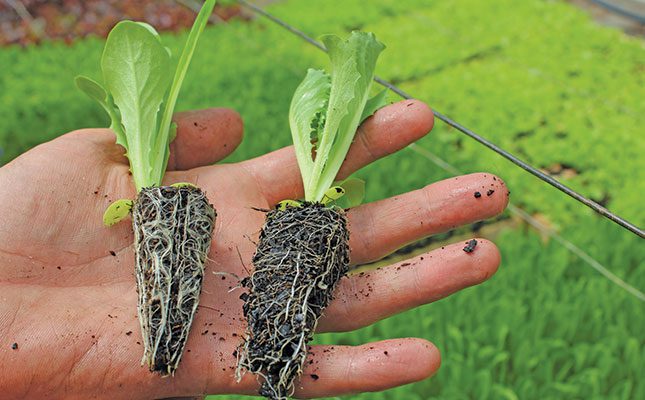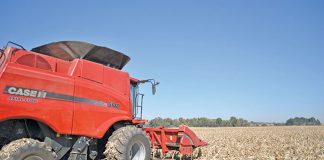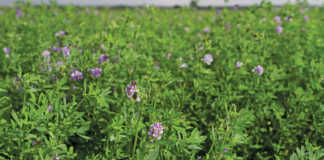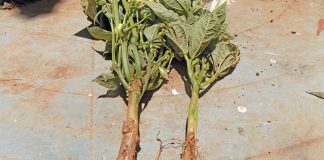
Photo: Lindi Botha
Sterkspruit farm, near Lydenburg in Mpumalanga, is situated at the very top of Long Tom Pass, 2 150m above sea level. Its position holds significant benefits for owner Jakkie Mellet: it is isolated from other farms, keeping it relatively safe from the potential spread of pests and diseases, and it is often wreathed in mist, which creates a microclimate ideal for the farm’s potato seed production.
On the other hand, the rocky nature of the land, being on the mountain top, means that only a fraction of the property can be cultivated.
Faced with this dilemma, Mellet sought alternative crops that could complement his potato seed operation. Cherries, berries and kiwi fruit were all considered, but only the last was feasible. Then, three years ago, he was approached by Woolworths to produce lettuce during the hotter summer months, when most of the retailer’s usual suppliers around Gauteng stop production.
“Lettuce is a cool-weather crop and it likes mild summer temperatures,” explains Mellet. “Farmers who typically deliver to Woolworths can keep up production in winter, but the summers are too hot, as the lettuce bulks up and starts to seed.
“Climate plays a crucial role in lettuce production, and it just so happens that the climate for potato seed production is also suited to growing lettuce: high altitude and high rainfall.”
\
Sterkspruit has annual rainfall of 950mm, mostly in summer. Summer temperatures peak around 30°C because of the farm’s position on top of the mountain. Moreover, the cold air travels down, keeping the evenings warm enough for production.
“Although the area gets frost, the lettuce doesn’t seem to mind. The leaves can be covered in frost in the early morning, and by the time the sun is out, the frost is gone and the plants just continue as normal.”
Mellet notes that while winter production is possible at the 19°C day-time average, it is not profitable. “The cycle extends from six weeks up to 10 weeks, which is just too long. It doesn’t make economic sense.”
Production
Mellet’s lettuce season runs from the middle of October until the end of May. The production cycle takes seven weeks early in the season, and averages six weeks once summer is in full swing.
A downside of the Lowveld climate is the prevalence of hail.
“It’s not if, but when and how much hail we get in a season. This is one of the reasons we plant the lettuce under a hail net, in bags filled with sand. We run a hydroponics system, and the sand is there just to keep the plants upright in the bags,” explains Mellet.
The lettuce production cycle starts with seedling production. This is handled in dedicated facilities on-farm under the expertise of the potato seed production team. Being able to produce their own seedlings is also a cost saving, as the transport costs of seedlings to this isolated farm would be prohibitive.
Some 75 000 seedlings are produced each week. The seeds are planted by hand in trays filled with a compost mix, then kept in a temperature-controlled room at 18°C for three days to germinate. They spend three weeks in the nursery and another week out in the open to harden before being planted in the 3ha growing area. A total of 342 000 seedlings of 11 varieties are planted, and this produces 25t/ha every six weeks.
Lettuce production has a high labour requirement, and Mellet employs 18 permanent workers. Weeds are a major concern, as they have to be removed by hand. To reduce this problem, a weed mat is used in the growing area, and this, according to Mellet, cuts the labour component by two full-time workers.
All water and nutrients are provided via an irrigation system that administers eight pulses a day. Each bag has its own dripper, dispensing around 7mm of water per pulse and 56mm/ plant/day. The water’s electrical conductivity (EC) is measured when the water goes into the bag and again when it runs out.
Mellet explains that the EC should always be lower in the water seeping out of the bag; if it is not, salt is building up in the bag. To prevent this problem, the bags are flushed daily with clean water to remove any excess salts. Rain provides this flushing action during summer, so on rainy days the manual flush can be skipped.
Mellet says that adhering to the irrigation schedule is crucial and a generator has therefore been installed for periods of load-shedding.
Trial, error and success
Reducing the time to harvest is a crucial element in profitable, sustainable lettuce production, according to Mellet. He and his staff constantly use trial and error to find the optimal recipe.
“We’ve tried many things over the years and have landed on a formulation that gives us good results. But the exact fertigation recipe for the best production is still a mystery.
Producing lettuce is a bit of an art. Simply growing the crop is not difficult, but to do so profitably, and get a consistent turnaround of six weeks or less, is tricky. Each grower has his or her own trade secrets and is reluctant to share this competitive advantage!”
One change being implemented as a result of their trials is a switch from compost to a coco peat mixture in the nursery. It was found that using the latter at the start of the growing process reduced the time to harvest by between seven and 10 days.
Although the coco peat mixture is more costly, it has solved the bottleneck experienced on the farm between planting and harvesting.
“Once the seeds are planted, it’s a four-week wait before they’re ready for planting out. With a weekly planting cycle, this means nearly 1 200 trays taking up space. Reducing this waiting time by a week means fewer trays, and I save an entire week of management and inputs. That adds up to quite a significant sum.”
The farm has also switched from white to black seedling trays, as the latter absorb more heat and reduce the growing time.
“In the salad game, it’s about turnaround, so the faster you can get the product out, the lower the production costs,” says Mellet.
Sterkspruit’s nursery manager Werner Schutte does his bit to reduce growing time and cost by fine-tuning nutrition. To this end, he uses biological products as far as possible to aid soil and plant health.
Schutte had a recent breakthrough when he discovered a new formulation containing a nano-fertiliser. This product results in a significantly higher uptake of nutrients in the plants, and has brought about a dramatic reduction in seedling production cost from R0,60/seedling to R0,06/seedling.
While he is reluctant to reveal the exact specifications of the product, Mellet says it contains a range of beneficial fungi and bacteria that aid plant health and drastically increase nutrient uptake.
The drive to move away from harsh chemicals is hindered by the lack of a biological solution to prevent biofilm from building up on irrigation systems.
“I have to flush the pipes with hydrogen peroxide after every cycle to keep them clean, and this kills all the beneficial bacteria and fungi. So with every cycle, we have to start afresh to build them up again.”
Mellet adds that the isolation of the farm means there is little disease pressure, with only a few incidents of white lice from time to time.
“We diligently follow the Farming for the Future and GlobalGAP pest management programmes, scouting and then spraying only when necessary. But there are some issues that are better handled with a set programme, because the risk of damage is too high to take a chance.
“Complying with all the regulatory bodies can turn into a paper war, but much of it is just good agricultural practices that should be in place anyway.”
Harvest
A lettuce grower has to keep a keen eye on the temperature and cold chain at harvest time to maintain optimal freshness and a longer shelf life.
“If it’s going to be a really hot day, we start harvesting at 5am, then stop at 11am, and restart at 3pm. It’s only 1km from the land to the cold room, but even along this short distance the lettuce can wilt if the temperature is too high. With lettuce, something as seemingly insignificant as this can affect quality.”
The lettuce is cut off above the roots when harvested and the roots are left in the sand. The new seedling is then planted next to it. Mellet aims to use the same soil for two years before replacing it, and removing the entire root would result in the loss of too much sand. Before the new seedlings are planted, however, the bags are sterilised with a hydrogen peroxide solution via the irrigation system.
Once the lettuce has been cut, it is placed in lug boxes and sent to the cold room on the farm. A transport contractor collects the produce two or three times a week, keeping the temperature at a constant 8°C. Once the lettuce is received at the Woolworths packhouse, it is cut up, washed and sorted.
Sterkspruit farm is around 300km from the Woolworths packhouse, and transport is Mellet’s greatest expense. However, using a contractor eliminates much of the strain that would go with managing a transport fleet himself.
A balancing act
Having to cope with the vagaries of the lettuce market is by far Mellet’s biggest overall challenge. He is expected to meet larger-than-anticipated quantities, as well as manage excess production when the demand unexpectedly drops.
“We only produce on order, but this can vary quite a bit. At the beginning of the season, when people are not eating that much salad yet, we produce about 8t/ week, and this goes up to 16t/week over Christmas and the peak summer months.”
Mellet has mixed feelings about the market. “Lettuce is not a great commodity to be in when the economy is under pressure, because it’s the first thing people stop buying. It’s not a staple food, and contains no protein and not much of nutritional value. It’s a nice-to-have. Although there’s a segment of the population that’s growing in affluence and we do see potential for some growth, demand fluctuates.
“The weather plays a big role. If it suddenly gets overcast and the weekend braais are cancelled, salad sales drop. I’ll deliver 4t one day and 2t the day after, as demand drops.
It’s a very difficult market to be in. But when it goes well, we smile. We’ve made peace with having to feed a certain portion of production to our cattle.”
Mellet aims to reduce the number of leaves wasted at the packing level because of blemishes or wilting. “Around 60% of what we produce is discarded during the packaging phase. Producing under a net helps, but we need to go further.
“To remain sustainable, we need to ensure greater efficiency, and put out a heavier head of lettuce using less time and fewer inputs. Through better management of all the steps along the way and all the inputs, we can make gains in this regard. We’re constantly trying to find better, more efficient ways of producing better-quality lettuce that matures faster.”
Email Jakkie Mellet at [email protected].










